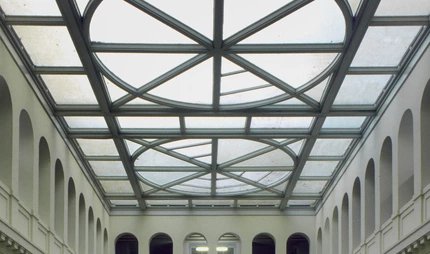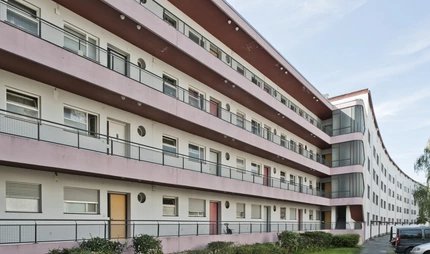
Haus der Kulturen der Welt
A gift from the US government to the city of Berlin in 1957
Today, the Haus der Kulturen der Welt in Berlin is a forum for contemporary art and critical debates: Exhibitions, concerts and performances illuminate artistic positions, scientific concepts and political issues.
Pregnant oyster - that's what Berliners call the Haus der Kulturen der Welt (House of World Cultures). The shape of the building with its round, gently curved roof certainly resembles an open oyster. And there are hidden pearls to be discovered inside, too. But as fitting as the nickname may be - it somewhat belies the exciting history and present-day programme of the house.
A cosmopolitan forum for contemporary art and topical discussions: Arts of all kinds and from all over the world are at home in the Haus der Kulturen der Welt, from theatre and dance, film and literature, readings and exhibitions to performances that mix all the arts and dissolve boundaries.
Social and artistic themes are questioned and discussed here, the house being a place of exchange and lively conversation. Once a year, children in particular rush into the House of World Cultures when the Berlinale shows its children's film series in the large hall in February.
The popular open-air spectacle Wassermusik (Water Music) in summer is a musical voyage of discovery to a particular region. On the terrace overlooking the Spree there are unusual concerts, plus films and documentaries.
Built in 1957 as a congress hall
As a contribution to the International Building Exhibition of 1957, the American architect Hugh Stubbins built the Congress Hall directly on the Spree. During the German division and the Cold War, it was a symbol of German-American friendship and a place for the free exchange of opinions in the West. Especially the striking free-floating roof construction was considered extraordinary. But it was precisely the roof that partially collapsed in 1980 due to structural damage. It was not until 1987 that the building was rebuilt true to the original for Berlin's 750th anniversary.
In 1989, the year the Berlin Wall came down, the Congress Hall became the new Haus der Kulturen der Welt and began to build up its current programme.
The Carillon
For Berlin’s 750 year anniversary a bell tower was constructed beside it. It is the largest carillon in the world, with 68 bells. Every Sunday at 3 p.m., and on many public holidays there is a concert – played live in the bell tower.
Comprehensive information on Berlin Modernist buildings and their history can be found on our website:
On Berlin Modernist Architecture
The “Auster” restaurant
The “Auster” restaurant not only has seafood on the menu, but also serves traditional dishes with a glorious view of the Spree. Perfect for a refreshment during the discussion after an event.
Parking at the Haus der Kulturen der Welt
The Haus der Kulturen der Welt does not have its own car park. Limited parking is available on John-Foster-Dulles-Allee. The best option, however, is to come by bus or bike.
Riverboat station
You can also come by ship: the Haus der Kulturen der Welt is Berlin’s only event venue with its own riverboat station.



